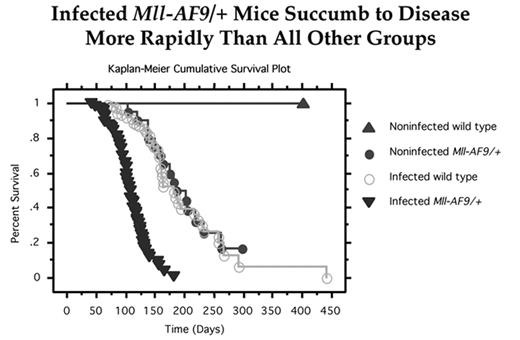Abstract
Human translocations involving the MLL gene are associated with a variety of myeloid and lymphoid leukemia. The MLL-AF9 translocation is common in acute myeloid leukemia (AML). C57BL/6 mice with a Mll-AF9 knock-in mimic the phenotype observed in human patients with this translocation: most develop AML but only after a preleukemic phase and prolonged latency. A minority of these mice develop acute lymphoblastic leukemia (ALL) (Dobson, et al. EMBO J. 1999, 18(13)). This model provides a system for understanding the evolution of AML initiated by a MLL fusion oncoprotein, including the identification of cooperating genetic events required for AML induction. The recombinant retrovirus MOL4070LTR (M4070) induces AML in some strains of mice (Wolff, et al. J Virol. 2003, 77(8)). We hypothesized that this virus could cooperate with the MLL-AF9 oncoprotein to accelerate AML by acting as an insertional mutagen, providing second hits in leukemia progression. We bred Mll-AF9 heterozygous C57BL/6 males to 129/SvJ wild type (WT) females, and injected the 280 offspring at 3 days of age with either M4070 virus (212) or a control supernatant (68). All mice were genotyped and observed for disease progression. Infected Mll-AF9/+ mice succumb to disease with a significantly reduced latency period when compared to virus treated WT mice (p < .0001) and uninfected Mll-AF9/+ mice (p < .0001), indicating that M4070 infection causes significant leukemia acceleration in these mice.
InfectedMll-AF9/+ Mice Succumb to Disease More Rapidly Than All Other Groups
InfectedMll-AF9/+ Mice Succumb to Disease More Rapidly Than All Other Groups
The gross pathology and analysis of the surface immunophentoype by flow cytometry and Southern blot indicate infected Mll-AF9/+ animals present with primarily myeloid leukemia while infected WT animals present with lymphoid leukemia. Retroviral insertion sites were cloned from 169 of our accelerated leukemia tissues using a shotgun-based, linker-mediated, cloning protocol to identify the genes most frequently mutated in these animals. From more than 20,000 sequence reads, over 4,700 independent proviral insertions were isolated and have been analyzed to identify 88 common insertion sites (CIS) present in at least 3 mice. We have found several CIS enriched in Mll-AF9/+ AMLs accelerated by M4070 insertion. We are examining the expression of CIS-associated genes in human AML with MLL gene translocations using human microarray data and in our murine leukemia samples using qRT-PCR to verify the viral insertions altered the expression of the candidate gene. We intend to test some of these genes for cooperation with MLL-AF9 in AML development using mouse transplantation assays. We are currently transducing bone marrow from Mll-AF9/+ mice with a retrovirus encoding a candidate gene to observe disease progression compared to controls.
Author notes
Disclosure: No relevant conflicts of interest to declare.


